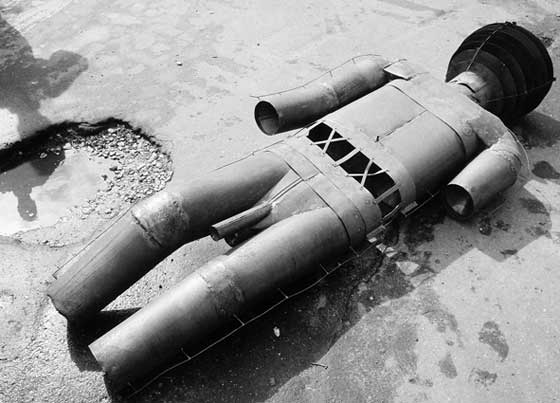|
|
| The Robot dives deeper Stella Pelše, Art Historian Collection of the Latvian Contemporary Art Museum: Juris Putrāms. Kamikadze – propogandist. 1990 | |
| As one of the 1980s groundbreaking generation of artists, Juris Putrāms – graphic artist, painter, instigator of happenings and maker of installations – is known for his expressively sur¬real, grotesque images, in which individually more sensitive and introvert features have also been observed, in comparison with the rest of the supergraphics artist group (Andris Breže, Ojārs Pētersons, Kristaps Ģelzis and others),(1) symbolizing the trauma and aspects of transformation and resistance of the political and social transition period. The hybrid chameleon, firetoad and embryo forms created later also reveal the fragility and limitedness of the human element, as well as a permanent desire to uncover the subjectively detected truth to the maximum depth possible. “Every fact leaves behind it traces. But rarely are they hopeful.”(2) | |
 Juris Putrāms. Kamikadze – propogandist. Object. Steel. 235x96x50 cm. 1990 | |
| The steel object Kamikaze – propagandist was on show at the exhibition Latvia. 20th Century Somersault. 1940–1990 (curator Helēna Demakova) which took place in the exhibition hall ‘Latvija’ in 1990, and stood out with many large-scale installations in the spirit of Fluxus and Arte Povera. The exhibition is regarded as a significant step towards the consolidation of the practice of contemporary art and the institution of curator – it “demonstrated a mature and convincing interaction of a new manipulation of form and conceptual thought. (..) It was an attempt to conceptually mark out the ‘somersault’ of historical development that Latvia had to make after a long period of isolation, trying enter into global cultural circulation.”(3) In this case, the way of exhibiting the object and the context is important – viewed in isolation on a horizontal surface, the metal sculpture is reminiscent of the helpless outer shell of a vaguely human-shaped, out of order robot. In the exhibition, the figure had been hung up head down on the diagonal, as if illustrating some desperately suicidal action (e.g. smashing with the head against the ground), the term ‘kamikaze’ in the title being a reference to the practices of Japanese suicide pilots in the World War II. The thread of this theme can be unwound further if wished, for example, by considering the higher aims of art (or of the transformation of society) which make personal lives insignificant. Rather in keeping with the paradigm of the artist/outsider: to provoke, challenge, make viewers think and feel uncomfortable – Putrāms himself is a personality who knowingly oversteps the bounds of everyday routine, normality and convenience. “Putrāms’ works always have to be read in quite a broad context, they are characterized by poster-like literalness, yet the seemingly obvious narrative in Putrāms’ works often behaves like a little fish – it waves at the fisherman with its tail and dives down deeper.”(4) That is, any one absolute reading is not imposed. But how can the notion of human sacrifice for a higher cause be applied to a mechanical figure? The robot, which is programmed to self-destruct in the name of propaganda, at first seems to be clearly pointing to the Soviet past – the regime that oppressed the uniqueness of the individual and essayed to turn everyone into robots marching towards a communist future. However, people who have become forcibly or voluntarily ‘robotized’ can be regarded as indicators of a much broader range of contemporary existential problems, while on the other side of the process there is the, for now controversial, research where human short-term consciousness is downloaded into the immortal body of a robot.(5) (1) Austriņš, Raivis. Supergraphics Artists. Riga: Neputns, 2008, p.19. (2) Juris Putrāms. From: Art Exhibition ‘Latvia – 20th century Somersault. 1940–1990’: Sketch book 1. Compiled by Helēna Demakova. Riga: Jāņa sēta, 1990, p. 56. (3) Krese, Solvita. Exhibition Latvia – 20th Century Somersault. 1940–1990. From: Groundbreakers. Art of the 80s [CD]. Composer and editor Ieva Astahovska. Riga: Contemporary Art Centre, 2005. (4) Lejasmeijere, Ieva. Mākslinieks cīņā par mieru. Studija, 2001, April–May, p.14. (5) Vēvers, Jānis. Nokopēta apziņa sola nemirstību. Diena, 10 August 2010, p.16. /Translator into English: Filips Birzulis/ | |
| go back | |







